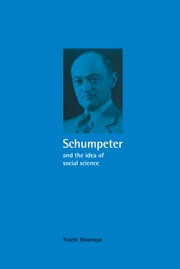Book contents
- Frontmatter
- Contents
- List of figures
- Preface
- 1 Introduction
- 2 Schumpeter and his surroundings: an overview
- 3 The scope and methods of Schumpeter's research program
- 4 The sociology of science and Schumpeter's ideology
- 5 The economic methodology of instrumentalism
- 6 Static economics as an exact science
- 7 The theory of economic development as a midpoint
- 8 A methodology of economic sociology
- 9 Economic sociology as an evolutionary science
- 10 The historical world of economics
- 11 Value judgments and political economy
- 12 Conclusion: Schumpeterian synthesis
- Notes
- List of references
- Index
3 - The scope and methods of Schumpeter's research program
Published online by Cambridge University Press: 18 September 2009
- Frontmatter
- Contents
- List of figures
- Preface
- 1 Introduction
- 2 Schumpeter and his surroundings: an overview
- 3 The scope and methods of Schumpeter's research program
- 4 The sociology of science and Schumpeter's ideology
- 5 The economic methodology of instrumentalism
- 6 Static economics as an exact science
- 7 The theory of economic development as a midpoint
- 8 A methodology of economic sociology
- 9 Economic sociology as an evolutionary science
- 10 The historical world of economics
- 11 Value judgments and political economy
- 12 Conclusion: Schumpeterian synthesis
- Notes
- List of references
- Index
Summary
Schumpeter's first book, Das Wesen und der Hauptinhalt der theoretischen Nationalökonomie (1908), was a recapitulation of neoclassical static theory from the methodological point of view. He then developed a skeleton of dynamic theory in Theorie der wirtschaftlichen Entwicklung (1912) and, after a long struggle, worked out a theoretical, historical, and statistical analysis of capitalist economic development in Business Cycles (1939). Finally, in Capitalism, Socialism and Democracy (1942) he provided an account of the evolution of the capitalist system by including not only economic but also political, social, and cultural factors. If we distinguish between Schumpeter's writings on the economy and society and his metatheoretical pieces, Wesen, Entwicklung and Business Cycles, and Capitalism are his major substantive works on economic statics, economic dynamics, and economic sociology, each of which deals with one of three areas of research, that is, the static state, the dynamic state of the economy, and sociocultural development as a whole, respectively.
A fragment of the sociology of culture?
What is the relationship between these three areas of research? Following the accepted view that Schumpeter's distinct contribution was the theory of economic development, it might be thought that the neoclassical static theory he discussed in Wesen was merely a body of thought to be superseded by his dynamic theory, namely Entwicklung and Business Cycles, and that Capitalism was a mere impromptu in sociology written for a popular audience.
- Type
- Chapter
- Information
- Schumpeter and the Idea of Social ScienceA Metatheoretical Study, pp. 31 - 53Publisher: Cambridge University PressPrint publication year: 1997



